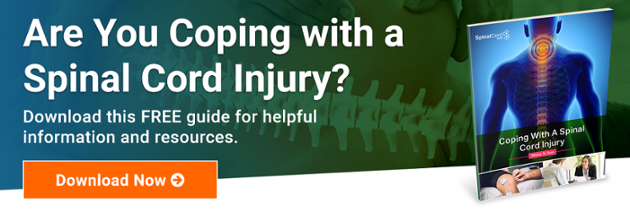4 Adaptive Feeding Devices for Quadriplegics
Independent eating often can be a challenge for people with cervical spinal cord injuries (SCIs). This is a particularly challenging task for quadriplegics and others with limited or no hand control. However, it doesn’t have to be that way. Adaptive feeding devices are available that can help you to regain some of your independence and successfully feed yourself without assistance.
Some of these devices are manual while others are automated, and they range greatly in terms of cost. However, regardless of your financial and physical limitations, the bottom line is that there is a device that can meet your needs.
We’ve put together a list of some of the useful adaptive feeding devices for quadriplegics.
Devices for Quadriplegics with Some Hand or Arm Mobility
1. Hand Cuffs for Using Cutlery
Hand cuffs (and clips, as they’re sometimes referred to) are manual devices that are easy to use and efficient for someone with little to no hand dexterity. There are several variations of hand cuffs and clips available on the market. These comfortable utensil holders are easy to put on and are useful for individuals who struggle with hand control.
Hand cuffs are very inexpensive ($9-$20), so you can afford to purchase a few of these items to keep in your home, vehicle, and carry with you in a wheelchair pouch. They’re also adaptable in terms of the type of utensils that you use (plasticware, metal utensils, even utensils that are angled or curved in design).
An added benefit of these assistive devices is that you can easily swap out your eating utensils for a toothbrush or another small item, if needed, to accomplish other daily functions.
Hand cuffs and clips are available from several websites, including:
2. Wrist Support for Using Eating Utensils
Similar to a hand cuff or clip, this type of device integrates eating utensils into the design of a supportive wrist brace. Some of the wrist support designs are full braces while others are more akin to splints.
Wrist devices are slightly more expensive than hand cuffs, but are definitely still affordable. They typically range in price from $20 to $30.
Robotic Devices for Quadriplegics with Limited/No Mobility
3. Meal Buddy
Robotic feeding arm devices are now available on the market. Although more expensive than manual devices we covered earlier in this article, these are excellent options for individuals who want to feed themselves but lack the hand or arm mobility.
The Meal Buddy adaptive feeding device consists of a robotic arm and three bowls that connect to a base via magnetic attachments. Its push-button and sip-and-puff (optional) activation options allow the user to be in control. You can choose the speed, bowl selection, and even program the position of the spoon.
In addition to having a wall plug, the device also has the option of a battery and charger as well that you can use when dining out with friends and family.
The cost of the Meal Buddy assistive device is about $3,535, plus any attachments and other options.
4. Obi
While it looks like something from the future, this device is available in the present. The Obi feeding device, which consists of a robotic arm holding an eating utensil and four integrated bowl-like compartments, provides a way for users with little to no hand or arm mobility to enjoy a meal with dignity and independence.
To activate the device, users have the option of using buttons, switches, and a sip-and-puff attachment. These switches can be activated by using your:
- Head;
- Shoulders;
- Arms;
- Legs;
- Feet; or
- Breath
Although not inexpensive, these devices are offered through flexible payment options. You can purchase the device outright ($5,950), lease it for 18 months ($235/month plus a $1,750 security deposit), or rent it monthly ($300/month plus a $1,250 security deposit).
There are a number of tools available to help with cooking and other daily tasks for people with quadriplegia. One great website for tools designed for C5-C7 quadriplegics is QuadTools.com.
We hope this information is helpful. If you have any other recommendations for adaptive feeding devices for quadriplegics, please be sure to share them in the comments section below.
Stay Updated on Advancements On Traumatic Brain &
Spinal Cord Injuries
About the Author





